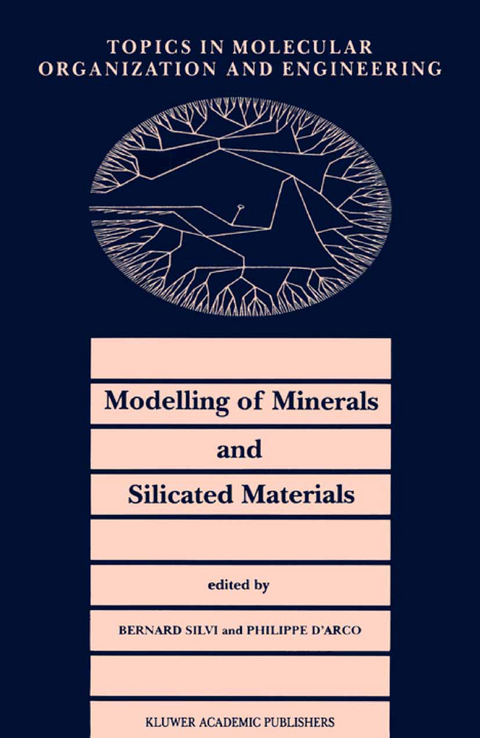
Modelling of Minerals and Silicated Materials
Seiten
1997
Springer (Verlag)
978-0-7923-4333-2 (ISBN)
Springer (Verlag)
978-0-7923-4333-2 (ISBN)
- Titel z.Zt. nicht lieferbar
- Versandkostenfrei
- Auch auf Rechnung
- Artikel merken
The modeling of minerals and silicated materials is a. The modeling of silicates and minerals covers a wide field of applications ranging from basic research to technology, from Solid State Physics to Earth and Planetary science.
The modeling of minerals and silicated materials is a. difficult challenge faced by Solid StatePhysics, Quantum Chemistry and Molecular Dynamics communities. The difficulty of such a modeling is due to the wide diversity of elements, including heavy atoms,and types of bonding involved in such systems. Moreover, one has to consider infinite systems: either perfect cr- tals or glasses and melts. In the solid state a given chemical composition gives rise to numerous polymorphs, geometricallycloselyrelated. These polymorphs have very similar energies and related thermodynamical pr- erties which explain the complexity of their phase diagrams. The modeling of silicates and minerals covers a wide field of applications ranging from basic research to technology, from Solid State Physics to Earth and Planetary science. The use of modeling techniques yields information of different nature. In the case of chemical studies, we can mention inv- tigations on catalytic processes occurring on surfaces and in zeolite cages. These calculations find possible applications in chemical engineering, in particular in the oil industry.
The modeling of minerals and silicated materials is a. difficult challenge faced by Solid StatePhysics, Quantum Chemistry and Molecular Dynamics communities. The difficulty of such a modeling is due to the wide diversity of elements, including heavy atoms,and types of bonding involved in such systems. Moreover, one has to consider infinite systems: either perfect cr- tals or glasses and melts. In the solid state a given chemical composition gives rise to numerous polymorphs, geometricallycloselyrelated. These polymorphs have very similar energies and related thermodynamical pr- erties which explain the complexity of their phase diagrams. The modeling of silicates and minerals covers a wide field of applications ranging from basic research to technology, from Solid State Physics to Earth and Planetary science. The use of modeling techniques yields information of different nature. In the case of chemical studies, we can mention inv- tigations on catalytic processes occurring on surfaces and in zeolite cages. These calculations find possible applications in chemical engineering, in particular in the oil industry.
The Structural Properties of Silica Using Classical and Quantum Interatomic Forces.- High Pressure Studies of Mantle Minerals by Ab initio Variable Cell Shape Molecular Dynamics.- Calculation of Mineral Properties with the Electron Gas Model.- Advances in Electron-gas Potential Models: Applications to Some Candidate Lower Mantle Minerals.- Quantum-mechanical and Classical Simulations of Mg-Ca Carbonates.- The SIO Bond and Electron Density Distributions.- The Nature of Silicon-oxygen Bonds in Silica Polymorphs.- Molecular Dynamics Simulation of Silica with a First-principles Interatomic Potential.- Molecular Dynamics Simulation of Silicate Glasses.- Application of the Partial Charge Model to the Aqueous Chemistry of Silica and Silicates.
| Erscheint lt. Verlag | 28.2.1997 |
|---|---|
| Reihe/Serie | Topics in Molecular Organization and Engineering ; 15 |
| Zusatzinfo | 81 Illustrations, black and white; IX, 341 p. 81 illus. |
| Verlagsort | Dordrecht |
| Sprache | englisch |
| Maße | 160 x 240 mm |
| Themenwelt | Naturwissenschaften ► Chemie ► Anorganische Chemie |
| Naturwissenschaften ► Geowissenschaften ► Geologie | |
| ISBN-10 | 0-7923-4333-6 / 0792343336 |
| ISBN-13 | 978-0-7923-4333-2 / 9780792343332 |
| Zustand | Neuware |
| Informationen gemäß Produktsicherheitsverordnung (GPSR) | |
| Haben Sie eine Frage zum Produkt? |
Mehr entdecken
aus dem Bereich
aus dem Bereich


